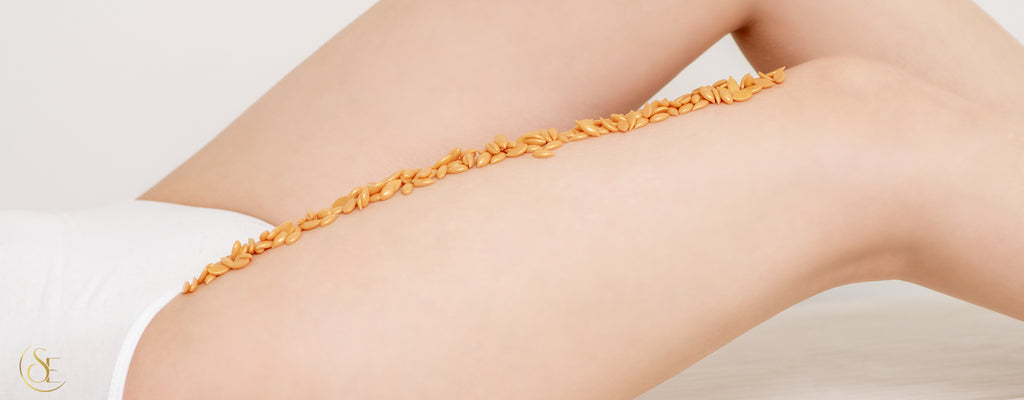La guía definitiva para la depilación con cera: consejos, técnicas y cuidados posteriores
Publicado por SUZANNE EGAN en

Seamos realistas: depilarse con cera es una de las mejores maneras de disfrutar de una piel suave y duradera. Tanto si eres una profesional de la depilación como si simplemente te encanta la sensación de recién depilada, tener la información adecuada marca la diferencia.
Esta guía completa lo explica todo, desde la selección de la cera adecuada hasta el cuidado de la piel después del tratamiento. ¡Listos, listos, a por todas!
¿Por qué optar por Italwax para su experiencia de depilación?
¿Te interesa saber por qué algunas depilaciones son suaves y fáciles, mientras que otras son un reto para tu piel? La respuesta está en la calidad de la cera. ¡Ahí es donde Italwax entra y cambia las reglas del juego! Sus productos de depilación de primera calidad te ayudan a conseguir la piel suave y sedosa de tus sueños.
Hecho con amor y adorado en todas partes
Italwax se produce bajo un estricto control de calidad. Es el Ferrari de los productos de cera: rendimiento de primera, fiabilidad y suavidad sedosa.
Agarre firme, menos dolor
Las fórmulas de cera corporal de Italwax están diseñadas para atrapar el vello con firmeza, pero sin dañar la piel. Esto garantiza una depilación máxima con mínimas molestias.
Opciones para todo tipo de piel y cabello
No todas las ceras son iguales, ni todas las pieles reaccionan igual. Italwax tiene:
-
Perlas de cera : para zonas delicadas como la línea del bikini.
-
Cera suave : Para zonas más prominentes, como las piernas.
- Cera de película Top Line : ¡ ofrece una combinación de ambos para una experiencia sedosa e indolora!
Los mejores consejos de depilación con cera para clientes y profesionales
Ya sea que realices una depilación casera o visites un salón, sigue estos consejos y obtendrás los mejores resultados en todo momento.
Prepárate como un profesional
Antes de empezar con un Sesión de depilación con cera , asegúrate de que tu piel esté:
- Limpio (sin aceites, lociones ni sudor).
- Exfolia suavemente (pero no justo antes de tu cita).
- Seco (la humedad puede impedir que la cera se adhiera correctamente).
Compruebe la temperatura de la cera
¡A nadie le gustan las quemaduras! Siempre prueba la cera en tu muñeca antes de usarla en una zona más extensa. Debe estar tibia, no incendiaria.
Estirar la piel
Para una cera más limpia, estira ligeramente la piel antes de retirar la banda. Esto minimiza el dolor y previene la irritación.
Tirón rápido, sin vacilaciones
Retire la banda de cera en paralelo a la piel, no hacia arriba. Tirar despacio duele más; tirar rápido da resultados limpios e indoloros.
Dale un poco de cariño a tu piel después de la depilación
Después de la depilación, usa aloe vera o una loción calmante. Además, evita:
- duchas calientes
- Bronceado o sol directo
- Frotarse la ropa apretada contra la piel
Cómo elegir la mejor cera para tu cliente (¡o para ti mismo!)
Seleccionar el kit de depilación adecuado es como encontrar el par de zapatos ideal: ¡DEBE ser perfecto!
¿Piel sensible? ¡Sé amable!
¿Piel sensible? Usa cera dura. La cera se adhiere solo al vello, no a la piel, así que es menos dolorosa.
¿Cabello grueso y áspero? ¡Puedes ser más duro!
Utilice cera depilatoria con alto poder adhesivo para vello grueso, como en piernas y axilas.
¿Rostro, línea del bikini y otras zonas sensibles? ¡Usa la fórmula correcta!
La cera dura es ideal para zonas sensibles ya que elimina el vello sin tirar de la piel.
Prueba de parche de cera: ¡Por qué es imprescindible!
¿Qué es una prueba de parche?
Una prueba de parche consiste en aplicar cera en una parte oculta de la piel antes de una sesión de depilación completa para comprobar si hay reacciones adversas.
Esta sencilla prueba ayuda a identificar si el cliente (o usted) tiene sensibilidades alérgicas, intolerancias cutáneas o reacciones imprevistas a la cera aplicada.
¿Cómo realizar una prueba de parche?
- Seleccione un área pequeña, como la parte interna de la muñeca o la parte posterior de la oreja.
- Utilice una pequeña cantidad de cera y límpiela como se espera en una sesión de depilación estándar.
- Espere 24 horas para observar cualquier reacción en la piel.
Si no presenta irritación, ¡listo! Si aparecen enrojecimiento, granitos o picazón, evite usar esa cera.
¿Cuánto tiempo hay que esperar antes de depilarse? ¡El tiempo lo es todo!
Depilarse en el momento equivocado puede provocar resultados irregulares o dolor indeseado. Aquí te indicamos cuándo reservar tu próxima sesión:
- El vello debe tener al menos 6 mm de largo (aproximadamente el tamaño de un grano de arroz). Suele crecer de 3 a 4 semanas después de la última depilación.
- La depilación regular te proporciona un crecimiento más suave y fino. Con el tiempo, la depilación hace que el vello vuelva a ser más fino y suave.
¿Demasiado pronto después de depilarte? La cera no se adherirá correctamente y te quedará una barba incipiente. ¿Demasiado tarde? ¡Se vuelve más doloroso!
Afeitarse entre citas de depilación: ¿buena o mala idea?
Respuesta corta: ¡No lo hagas!
Afeitarse altera el ciclo de crecimiento del vello, por lo que la cera no funcionará tan bien la próxima vez. Obtendrás un crecimiento desigual y zonas con barba incipiente en lugar de una cera suave y limpia.
Si odias el tiempo intermedio, usa un inhibidor del crecimiento del vello para ralentizarlo hasta la próxima depilación.
Depilación láser vs. cera: ¿cuál gana?
¿Deberías pasarte a la depilación láser o seguir con la cera? ¡Comparemos!
|
Característica |
Depilación |
Láser |
|
Resultados inmediatos |
Sí |
No |
|
Funciona en todos los colores de cabello |
Sí |
No (el láser no funciona bien en cabellos grises o rubios) |
|
Efecto a largo plazo |
No (el cabello vuelve a crecer después de un tiempo) |
Sí (Reducción permanente del vello) |
|
Costo |
Menos por sesión |
Caro por adelantado |
Veredicto final:
- Elige la depilación con cera si te gusta la suavidad instantánea y una rutina económica.
- Elija un láser si desea reducir el crecimiento del vello de forma permanente pero está dispuesto a invertir tiempo y dinero.
Pruebas de parche (¡otra vez!): porque son ASÍ de importantes
La depilación con cera es una de las maneras más efectivas de lograr una piel suave y sin vello. Pero antes de comenzar una sesión completa, hay un paso crucial que nunca debe omitirse: la prueba localizada.
Una simple prueba de parche puede prevenir reacciones alérgicas, quemaduras e irritación cutánea no deseada. Tanto si eres esteticista profesional como si te depilas en casa, este paso es esencial para garantizar una experiencia segura y cómoda.
Entonces, ¿por qué son tan importantes las pruebas de parches? Analicémoslo.
¿Por qué es importante la prueba de parche?
Mucha gente piensa que la depilación con cera es un tratamiento universal. Sin embargo, cada piel es única: lo que funciona para una persona puede causar una reacción en otra. Por eso, es fundamental realizar una prueba cutánea antes de depilarse:
Previene reacciones alérgicas
Algunas ceras utilizan ingredientes como:
- Resinas (que proporcionan a la cera su textura pegajosa).
- Fragancias o aceites esenciales (que pueden irritar la piel sensible).
- Tintes o colorantes (que pueden provocar alergias en algunas personas).
Incluso si has usado cera en perlas antes, la sensibilidad de tu piel puede cambiar con el tiempo debido a la edad, cambios hormonales o factores ambientales.
Una prueba de parche garantiza que su piel no se irritará, se hinchará ni desarrollará sarpullido después de una aplicación completa de cera.
Identifica la sensibilidad al calor
¡La temperatura de la cera es fundamental! Algunas personas tienen la piel muy sensible y reaccionan incluso al calor mínimo.
La prueba del parche le permite comprobar si el cliente (o usted mismo) puede soportar la temperatura sin quemaduras ni enrojecimiento.
Consejo profesional: Pruebe la cera en su muñeca de antemano y aplíquela solo después de que se haya enfriado si está demasiado caliente.
Previene la irritación severa y los brotes
Algunas personas no tienen alergias, pero aun así experimentan enrojecimiento intenso, picazón o ronchas después de la depilación. Las pruebas de parche te benefician:
- Determinar si una cera es demasiado agresiva para la piel sensible.
- Cambie a una fórmula más suave antes de comprometerse con una sesión de depilación completa.
- Reduce la irritación post-depilación y consigue resultados más suaves.
Imprescindible para quienes se depilan por primera vez
Una prueba de parche no es opcional si es tu primera vez depilándote con cera (o la primera vez de tu cliente).
Dado que quienes se depilan por primera vez no tienen idea de cómo se comportará su piel, esta sencilla prueba de parche evita sorpresas desagradables como enrojecimiento intenso, ampollas o descamación de la piel.
¿Quién debería hacerse una prueba de parche antes de depilarse con cera?
Quizás te preguntes: "¿Necesito una prueba de parche si ya me he depilado con cera antes?"
La respuesta es ¡SÍ!
Sí, incluso si te has depilado con cera antes, varios factores pueden hacerte más susceptible a sufrir una reacción.
¡Aquí está quién DEBE SIEMPRE hacer una prueba de parche antes de depilarse con cera!
Personas que prueban una nueva marca de cera
¡No todas las ceras son iguales! Una marca nueva que nunca has usado puede tener ingredientes diferentes a los que tu piel puede reaccionar.
Clientes de piel sensible
Se requiere una prueba de parche si usted o su cliente presentan regularmente brotes, se enrojecen o reaccionan a los productos para el cuidado de la piel.
Personas con afecciones de la piel
Cualquier persona que tenga eczema, rosácea o psoriasis debe realizar una prueba antes de depilarse para determinar si su piel puede tolerarla.
Clientes embarazadas u hormonales
Las fluctuaciones hormonales y el embarazo pueden sensibilizar la piel más de lo habitual. Una cera que antes era delicada ahora puede irritarla.
Personas que toman medicamentos que afectan la piel
Algunos medicamentos (como retinoides, Accutane o esteroides) adelgazan la piel y la hacen más susceptible a la irritación y el ardor. Una prueba cutánea evitará problemas graves.
¿Qué sucede si no se realiza una prueba de parche?
Pasar por alto una prueba de parche puede parecer algo sin importancia, pero esto es lo que puede suceder:
-
Enrojecimiento e hinchazón : Algunas personas experimentan una reacción desagradable después de la depilación. Una prueba cutánea previene esto.
-
Quemaduras dolorosas : La cera demasiado caliente o áspera puede quemar la piel. Explore nuestra exclusiva gama premium. Calentadores de cera y seleccionar el mejor.
-
Brotes y protuberancias : la piel frágil puede reaccionar a los ingredientes de la cera, provocando acné, puntos blancos o pelos encarnados.
- Cicatrices y pigmentación: Una reacción terrible a la cera puede producir marcas oscuras, costras o cicatrices permanentes.
Así que, la próxima vez que tú (o tu clienta) programen una cita para depilarse, pregúntate: "¿Hice una prueba de piel primero?". Si no, ¡hazlo de inmediato! Tu piel lo agradecerá.
La conclusión: ¡depílate de forma más inteligente, no más fuerte!
La depilación con cera no se trata sólo de eliminar el vello, sino también de cuidar adecuadamente la piel.
Recordar:
- Utilice cera de calidad como Italwax para obtener resultados óptimos.
- Mantenga una rutina de depilación regular para tener una piel suave.
- NUNCA omita la prueba del parche (¡la seguridad es lo primero!).
- Evite afeitarse entre sesiones para mantener los resultados intactos.
- Sea amable con su piel tanto antes como después de la depilación.
Confíe en los mejores del sector para la salud y el cuidado de su piel. Italwax ofrece los mejores productos de cera profesionales, diseñados para hombres y mujeres. Por otro lado, si desea convertirse en un experto en depilación profesional, Suzanne Egan Academy ofrece cursos de formación profesional en depilación para satisfacer diversas necesidades de aprendizaje. ¡Explore sus productos de depilación premium y elija los mejores para su piel hoy mismo!


